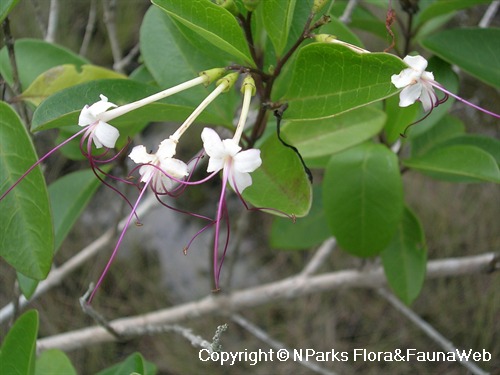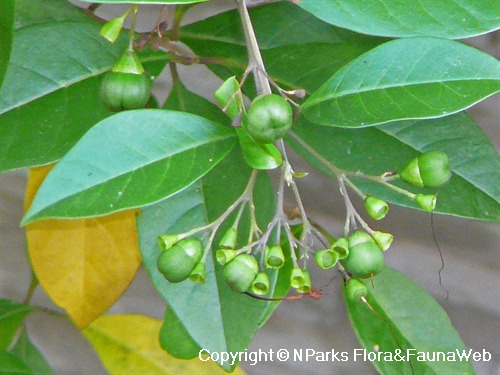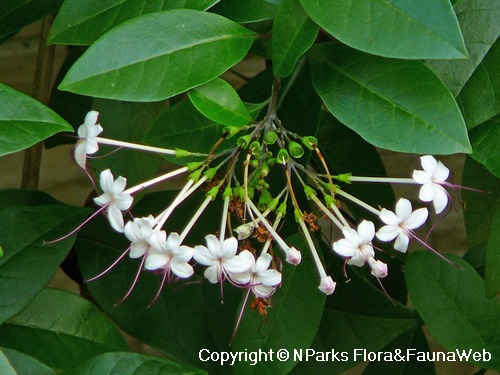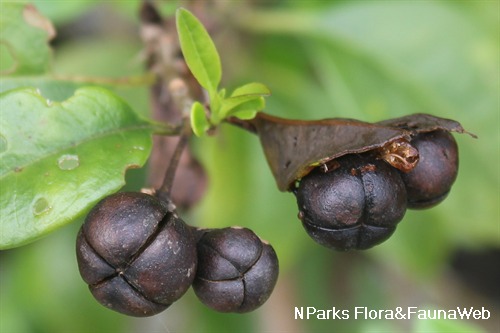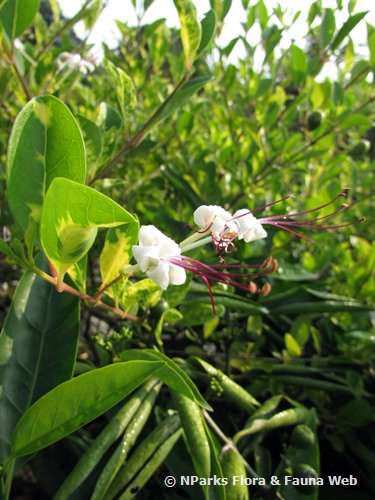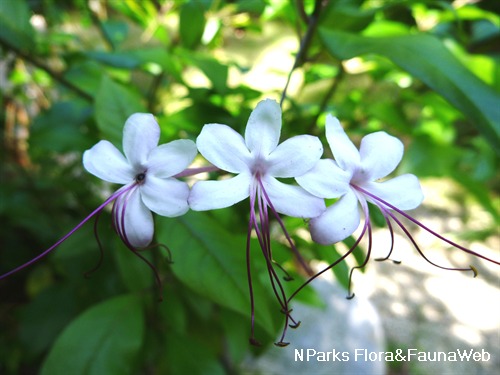
Back
Volkameria inermis L.
| Family Name: | Lamiaceae (Labiatae) |
| Synonyms: | Clerodendrum inerme (L.) Burm. f. |
| Common Name: | Indian Privet, Seashore Tubeflower, Bunga Pawang, Wild Jasmine, Sorcerers Bush, Seaside Clerodendrum, 苦郎树 |
Name
Classifications and Characteristics
| Plant Division | Angiosperms (Flowering Seed Plants) (Dicotyledon) |
|---|---|
| Plant Growth Form | Shrub, Climber |
| Lifespan (in Singapore) | Perennial |
| Mode of Nutrition | Autotrophic |
| Plant Shape | Irregular |
| Maximum Height | 3 m to 13 m |
Biogeography
| Native Distribution | Southern China, India, Myanmar, Peninsular Malaysia, Singapore, Australia, and Polynesia |
|---|---|
| Native Habitat | Shoreline (Mangrove Forest, Backshore) |
| Preferred Climate Zone | Tropical, Sub-Tropical / Monsoonal |
| Local Conservation Status | Native to Singapore (Least Concern (LC)) |
Description and Ethnobotany
| Growth Form | It is an evergreen erect bush that grows up to about 3 m tall, or a climber up to 13 m long. |
|---|---|
| Foliage | Its stalked leaves have membranous leaf blades that are oval or narrowly lance-shaped, not covered with hair when mature, and 3.8–8.8 by 1.8–4.3 cm, with inconspicuous veins. |
| Flowers | Its flowers grow in groups of 3–7 on the end of branches (axils). Its petals are white or tinged purple, and fragrant. |
| Fruit | Its drupe (fruit) is drop-shaped, bright green turning black or brown, and 0.8 cm in diameter. |
| Habitat | It grows on coasts, edges of mangrove forests, in saline marshes, swamps, and tidal mud. It occurs locally in Pulau Ubin and Pulau Tekong. |
| Associated Fauna | It is the preferred local food plant for the caterpillars of the butterfly gram blue (Euchrysops cnejus) and moth Acherontia styx. |
| Cultivation | It can be propagated by seed or stem cutting. |
| Etymology | Latin Volkameria, after Johann Georg Volkamer (1662–1744), who author the flora of Nuremberg; Latin inerme, defenseless, without spines or thorns, referring to the plant’s characteristics |
| Ethnobotanical Uses | Medicinal: A decoction of the root is administered as a febrifuge and general alterative. The leaves are used in poultices as a resolvent. Its seeds or its finely ground roots are used as a remedy for an upset stomach, especially if caused by poisonous seafood. This treatment is often combined with a decoction of the leaves, simultaneously employed as a bath but also as a drink. In Thailand, a decoction of the leaves or a poultice of ground leaves is used in the treatment of skin diseases and itches. In Vietnam, a decoction of roasted leaves is considered a remedy for beriberi. Its root boiled in oil is used as a liniment useful in rheumatism. Others: It is introduced in parts of the tropics to control erosion. |
Landscaping Features
| Landscaping | It is suitable for parks, streetscapes, and gardens as a bushy shrub. |
|---|---|
| Desirable Plant Features | Ornamental Flowers, Fragrant |
| Landscape Uses | Coastal, General, Suitable for Roadsides, Parks & Gardens, Small Gardens, Beachfront / Shoreline |
Fauna, Pollination and Dispersal
| Fauna Pollination Dispersal Associated Fauna | Caterpillar Moth Food Plant, Moth Food Plant, Butterfly Host Plant |
|---|---|
| Pollination Method(s) | Biotic (Fauna) |
| Seed or Spore Dispersal | Abiotic |
Plant Care and Propagation
| Light Preference | Semi-Shade, Full Sun |
|---|---|
| Water Preference | Moderate Water, Lots of Water |
| Plant Growth Rate | Fast |
| Rootzone Tolerance | Drought Tolerant, Moist Soils, Waterlogged Soils (Drains Site), Well-Drained Soils, Saline Soils / Salt Spray, Fertile Loamy Soils, Easy to Grow |
| Transplanting Tolerance | Good |
| Propagation Method | Seed, Stem Cutting |
Foliar
| Foliage Retention | Evergreen |
|---|---|
| Mature Foliage Colour(s) | Green |
| Foliar Type | Simple / Unifoliate |
| Foliar Arrangement Along Stem | Opposite |
| Foliar Attachment to Stem | Petiolate |
| Foliar Shape(s) | Non-Palm Foliage (Oval, Lanceolate) |
| Foliar Venation | Pinnate / Net |
| Foliar Margin | Entire |
| Leaf Area Index (LAI) for Green Plot Ratio | 4.5 (Shrub & Groundcover - Dicot) |
Floral (Angiosperm)
| Flower & Plant Sexuality | Bisexual Flowers |
| Flower Colour(s) | White, Purple |
|---|---|
| Flower Grouping | Cluster / Inflorescence |
| Flower Location | Terminal |
Fruit, Seed and Spore
| Mature Fruit Colour(s) | Brown, Black |
|---|---|
| Fruit Classification | Simple Fruit |
| Fruit Type | Fleshy Fruit , Non-Accessory Fruit |
Image Repository
Others
| Master ID | 527 |
|---|---|
| Species ID | 1823 |
| Flora Disclaimer | The information in this website has been compiled from reliable sources, such as reference works on medicinal plants. It is not a substitute for medical advice or treatment and NParks does not purport to provide any medical advice. Readers should always consult his/her physician before using or consuming a plant for medicinal purposes. |

